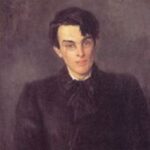William Butler Yeats: great Irish nationalist, winner of the Nobel Prize for Literature in 1923, and author of great poetry, plays, and prose. Yeats was deeply into occultism and mysticism, and was also active politically in Ireland. His failed love life and depressing environment led to his pessimistic works. One of Yeats’ greatest works, “The Second Coming,” was a dark prediction of the coming times. Written in the year 1919, “The Second Coming” reflected the hoards of revolutions, rebellions, wars, and overall anarchy. The fear of the general public was that the “Second Coming” of Christ was near.
Yeats’ “The Second Coming” follows the ideas of Matthew, Chapter 24 in the bible. Generally, this chapter predicts the coming of Christ, and also states that there will be deception by one who claims to be Christ. Yeats’ use of Matthew 24 reflects the feelings of deceit that Ireland felt toward the British who retained control of their land. The poem itself opens with the image of a falcon that can no longer hear the call of the falconer. One critic believes that the falcon represents Ireland, and the falconer represents England. Ireland now refuses to hear the calls and demands of England. Continuing this idea, the refusal of the falcon to hear the falconer leads to “Things fall apart; the center cannot hold. . .” The rebellious nature of this “falcon” leads to anarchy and war. The innocent that have no say in the actions of the collective “falcon,” are brought into the “blood-dimmed tide” that is “loosed.” In the second stanza, an explanation is offered for the images bestowed on the reader in stanza one. The Second Coming is the explanation that Yeats offers for the anarchy that is breaking loose. Yeats speaks of the Spiritus Mundi, and the “vast image” that arises out of it. This image of the “World Spirit” seems to be a manifestation of the collective consciousness of mankind. This image is one of the Sphinx rising from its two-thousand years of sleep, and makes its way toward Bethlehem. Another critic believes that the Sphinx may symbolize the Anti-Christ. On the other hand, it must be noted that the Sphinx is moving from the “cradle of civilization” to Bethlehem to be born. Yeats true intent is not completely stated, he may be discussing how the trying times feel as if the Second Coming is upon them, or he may be talking about the Irish fighting off British rule and suppression.
The form of this poem is fairly simple. There are two stanzas with different line lengths: the first containing eight lines and the second containing fourteen lines. The line structure along with the sparse rhyme lead to the idea of the anarchy described in this poem. The mass use of imagery aide in the understanding of the emotional discontentment of the Irish people and the pessimistic thoughts of the witnesses of the Second Coming. The language of the poetry is winding and enticing. When the “rough beast. . . Slouches. . .” an image is placed into the mind of the Anti-Christ or the image of the horror of the End. The words that Yeats uses bleeds into one another forming a living, breathing work. The anarchy in the first stanza forms an awkward unity of verse. The second stanza forms an almost follow-up statement concerning the outcome of the anarchy. The use of vivid imagery and allegorical tone give “The Second Coming” and eerie glow.
Yeats’ “The Second Coming” is a terrifying view on the future, one that hopefully does not come true. On the other hand, it was a great work that cried the Irish nationalism with a loud, strong voice. Whether “The Second Coming” was literal in its interpretation of the Coming of Christ or whether is was a rallying cry of the Irish, it was still a great work of Yeats. Its strong, influential language has proven to stand the test of time and will continue to be one of the greatest works ever written.




